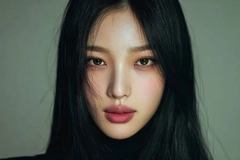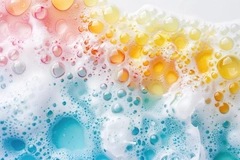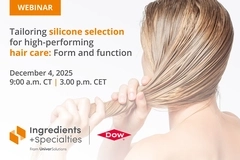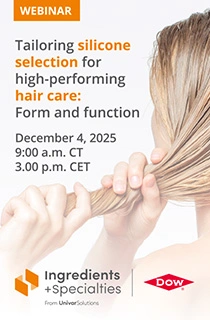Global beauty trends: Understanding consumer choices
Explore the latest beauty trends and product launches in the cosmetics industry
05 Aug 2024 --- The cosmetics industry is evolving, driven by technological advancements, environmental awareness and changing consumer preferences. Global factors like sustainability, inclusivity and demand for personalized experiences are shaping the beauty landscape.
Each year, through extensive 360 research, Innova Market Insights releases the Top 10 Trends for the upcoming year. Innova considers various trend drivers, along with consumer trends and in-depth tracking of beauty product launches — including categories, product features, ingredients and on-package claims — to predict the new trajectories of the global cosmetics market.
Trend #1: Skinifying Beauty
Global beauty trends research shows that consumers are seeking added value from ingredients. Notably, 67% of consumers globally prefer makeup products with added skin care benefits. This trend underscores the consumer priority for functionality and performance. Globally, there has been a 32% rise in beauty launches with common skin care actives over the past five years. Among these, ceramides have gained significant popularity due to their benefits, driven by consumer demand and brand innovations.
Brands are tapping into “skinification” and also highlighting ceramides in their beauty products. For instance, MAC’s new serum-powered foundation highlights 33 skin care ingredients and Maybelline New York lash sensational sky-high tinted primer features ceramide.
Trend #2: Multitasking Marvels
Global beauty trends research into the cosmetics industry reveals that consumers are looking for less time consuming makeup routines. Some 45% of consumers globally say that they use 1–3 makeup products in their makeup routine. The minimalism trend has gained popularity due to social media and the desire to manage makeup expenses. This trend is evolving to include multifunctional makeup products for quicker, hassle-free routines.
The “Multitasking Marvels” trend highlights that brands are developing multifunctional products in cosmetics to align with minimalist routines, which has led to 11% growth in multifunctional products. Hybrid launches featuring SPF protection, like Shiseido’s Revitalessence Skin Glow Foundation SPF 30 PA++ and Elizabeth Arden's 8 Hour Cream Lip Protectant Stick SPF 15, demonstrate this trend. Brands can watch out for the growing interest in multitasking products like lip, cheek and eye tints in the hybrid makeup wave.  Global consumers increasingly seek added value from ingredients, notably skin care benefits.
Global consumers increasingly seek added value from ingredients, notably skin care benefits.
Trend #3: Ethical Aesthetics
In recent years, consumers have become more conscious of the environment, preferring sustainable options without compromising on the aesthetic appeal of the product. Some 78% of Gen Z and Millennials consider packaging an important factor when buying makeup. The trend “Ethical Aesthetics” highlights that consumers seek both sustainability and well-designed aesthetics in cosmetics packaging.
Global beauty trends research indicates that the majority of younger consumers are swayed by social media profiles and influencers. Aesthetic social media posts encourage new attractive and sustainable product designs. To cater to this demand, several brands are highlighting their commitment to the environment through ethical packaging.
For example, Chanel No. 1 Red Camellia Complexion Beautifier Foundation features a low carbon footprint, while Bareminerals Original Mineral Veil Loose Setting Powder highlights plastic-free packaging.
In the global beauty market, consumers also look for products that are cruelty-free, sustainably packaged, recyclable and available in limited editions. This trend signifies a growing demand for cosmetics that align with both ethical values and aesthetic appeal.
Trend #4: Gen Z: The Gamechangers
Gen Zs are experimenting and bringing changes into the cosmetics industry. Some 52% of Gen Z consumers are willing to try out new makeup products, highlighting them as key trendsetters in the global beauty market. This trend highlights how Gen Z is advocating for transparency in brand ethics and creating social media-fueled trends. Gen Z displays a high interest in experimenting with makeup products, such as menthol formulas for plumping, liquid eyeshadow formats and liquid blushes with sponge applicators.
Social media platforms like TikTok play a significant role in capturing Gen Z’s interest, with microtrends sparking their curiosity and driving product exploration. Gen Zs are expecting brands to maintain high levels of transparency, featuring authentic sustainable certifications and non-animal tested formulations without harmful toxins. Brands can capitalize on this trend by highlighting their sustainable certifications and transparent practices via product communication.
Trend #5: Collaborative Crossovers
In the global beauty market, brands are experimenting and breaking boundaries. The “Collaborative Crossovers” trend highlights brands coming up with interesting collaborations with streaming platforms, which include TV shows, celebrities and the food and beverage industry. Brands are trying to engage with consumers through art, clothing brands, films and series.
For instance, Revolution Beauty recently launched a range of cosmetics to celebrate the 20th anniversary of the film Elf. Similarly, Lancôme's collaboration with Le Louvre blends art and beauty. Top streaming platform shows also inspire makeup collaborations, while food-inspired makeup is trending as well. Taste Beauty collaborates with food brands to launch fun, youth-oriented makeup products. This trend highlights the brand’s diverse ways to engage with consumers by tapping into popular culture and creative partnerships.  Social media and affordability are driving the minimalism trend in cosmetics.
Social media and affordability are driving the minimalism trend in cosmetics.
Trend #6: Age of Localization
This trend highlights consumers’ loyalty toward local brands. Globally, 18% of consumers associate sustainable beauty with buying local products. This trend shows that local brands are in tune with their country's demographics, catering more directly to these specific consumers.
Local beauty trends are developing uniquely by country. In South Korea, caramel blush shades and feathered eyelashes for a youthful makeup look are rising. Meanwhile, in China, there is a growing trend of incorporating traditional Chinese medicine and fermented ingredients, such as ginseng, into beauty products. This indicates how local brands are diversifying and catering to specific consumer needs.
Companies can build consumer excitement about trying local cosmetic products by emphasizing “vocal for local” campaigns. This approach not only meets the demand for sustainable beauty but also builds a deeper connection between brands and their regional audiences.
Trend #7: Blurring the Gender Lines
Gender-based barriers in the global beauty market have been weakening over the past few years. The “Blurring the Gender Lines” trend displays the widespread concern for gender inclusivity, which has pushed cosmetics companies to introduce more gender-neutral and inclusive products. Some 53% of consumers globally think that beauty products should be gender-neutral. This shift is reflected in the significant 89% rise in male cosmetics launches over the past five years, indicating increased usage and interest in makeup among male consumers.
As a result, new beauty product launches are featuring gender-neutral claims. Overall, this trend underscores the cosmetics industry’s commitment to reflecting diverse identities and fostering an inclusive beauty landscape.
Trend #8: Starstruck
Global beauty trends research displays that nearly 1 in 5 Gen Z and Millennials find celebrity, influencer brands and endorsements appealing. This trend reveals how celebrities and influencers are launching their own beauty brands by leveraging their established fanbases.
Lady Gaga’s Haus Labs and Katrina Kaif’s Kay Beauty display celebrities capitalizing on their existing popularity. Their strong consumer base and active social media presence are key drivers behind their popularity. Beauty brands can collaborate with social media influencers to drive consumer interest and product popularity.  Planetary health remains top of mind for consumers, bringing responsible packaging into focus.
Planetary health remains top of mind for consumers, bringing responsible packaging into focus.
Trend #9: Powders to Pixels
Global beauty trends research shows that the cosmetic industry is using AI tools to enhance their products. Consumer demand for higher efficiency and personalization has led to the emergence of AI and machine learning in cosmetics innovation. Brands like Dcphyer are leveraging AI-powered tools to create customized face cosmetics tailored to individual skin tones and textures.
Simultaneously, beauty brands are exploring the metaverse, integrating gamified experiences with reward points and other privileges to promote their products in interactive ways. As technology continues to evolve, the integration of AI and immersive digital experiences is likely to redefine brand-consumer interactions, paving the way for even more interactive solutions.
Trend #10: Future Nostalgia
Consumers are experiencing nostalgia for beauty trends, fueled by the rise of microtrends on social media platforms like TikTok. Global beauty trends research highlights that Gen Zs are reclaiming past trends from the 1990s or 2000s with a modern twist.
The resurgence of Y2K makeup looks, which began in mid-2022, has evolved into a significant trend across social media. This is driven by nostalgic inspiration from Barbie, grunge, chrome and choco makeup, highlighting a unique blend of past and present makeup styles. The ongoing combination of nostalgic and modern elements is likely to make beauty trends dynamic and constantly evolving.
This article is based on the Innova Market Insights report “Top 10 Trends 2024 - Beauty – Global.”














